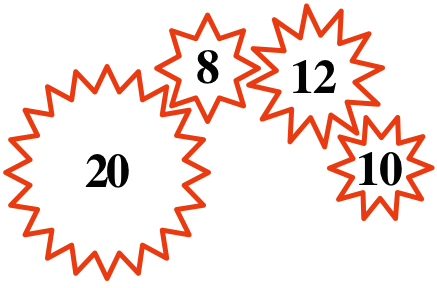Like Clockwork
 How many rotations will the gear with 8 teeth have made when the gear with 10 teeth completes its 48th rotation?
How many rotations will the gear with 8 teeth have made when the gear with 10 teeth completes its 48th rotation?
This section requires Javascript.
You are seeing this because something didn't load right. We suggest you, (a) try
refreshing the page, (b) enabling javascript if it is disabled on your browser and,
finally, (c)
loading the
non-javascript version of this page
. We're sorry about the hassle.
11 solutions
I think the easiest way is an eye for an eye, a tooth for a tooth. 10 tooth gear, 48 rotations comes out to 480 teeth. 480 teeth, 8 tooth gear comes out to 60 rotations.
Log in to reply
this is a better way i like this method easy and logical
It's mechanism is like gear, so formula is N1/N3=Z3/Z1 Where N=Number of Rotations Z=Number of teeth So, N3=(10/8)x48=60 rotations.
If first wheel has x no. of teeth n-th wheel has y no. of teeth: 1 rotation of first wheel = x/y rotations of n-th wheel. Therefore, 48 rotations of first wheel = 48 * (x/y) rotations of n-th wheel. Here: x=10; y=8, so, 48 rotations of first wheel = 48 *(10/8) rotations of 3rd wheel; or, 48 rotations of first wheel = 60 rotations of 3rd wheel.
well the answer is really simple and its based on the fact that the number of gears is inversely proportional with the number of rotations so lets say N is the number of rotations and Z is the number of gears therefor Z10/Z12 = N12/N10 and we already know that Z10=10 and Z12=12 and that N10=48 so by substituting in the previous equation we find that N12=40, using the same principle Z12/Z8=N8/N12 again Z12=12, Z8=8, N12=40 therefor N8= the number of rotations of the gear 8 by the time gear 10 has done 48 rotations =60 rotations
Awesome :)
The 12 wheel rotates a full rotation through 1.2 complete rotation of the 10 wheel, thus 48/1.2 equals 40, while the 8 wheel rotates a complete rotation through 0.6666667 rotation of 12 wheel, therfore 40/0.666667 equals 59.9 =60 approximately
One rotation of 10 toothed gear rotates 1 2 1 0 of the 12 toothed gear and 8 1 0 of the 8 toothed gear.
So for 48 rotations of the 10 toothed gear, the 8 toothed gear will rotate 4 8 ⋅ ( 8 1 0 ) = 6 0 times.
48 (10/12) (12/8) = 48*(10/8) = 60.
when 1 tooth moves every tooth moves, hence when 10 teeth moves of A 10 teeth of B also moves.Since B have 8 teeth it moves 1 revolution and 2 teeth. similarly when 48 revolution of 10 goes then 480 teeth i.e, 480/8 revolution of B
N1 T1=N2T2=N3T3=N4T4 whre N is the number of rotations and T is the number of teeth. here N1=48, T1=10 , T3=8
But how we know exactly the gear that moves? Because we should consider the mechanisms of the gear too. Maybe 10-gear and 12-gear are not compatible too. Maybe the the movement of gear is not correct too.
If first wheel has x no. of teeth n-th wheel has y no. of teeth:
1 rotation of first wheel = x/y rotations of n-th wheel.
Therefore, 48 rotations of first wheel = 48 * (x/y) rotations of n-th wheel.
Here: x=10; y=8, so,
48 rotations of first wheel = 48 *(10/8) rotations of 3rd wheel; or,
48 rotations of first wheel = 60 rotations of 3rd wheel.
I wonder why every body speak of gears while it is the teeth that mesh together. In gear system every meshing gear must have identical teeth. So the number of teeth engaged in the movement will be the same for every gear wheel. Number of teeth per wheel times the number of rotation gives the number of teeth engaged in the operation. It is same for every wheel and thus makes life simpler. Thanks and regards.
48/8 = 6 => 10*6=60
Just first of all forget about the rotation angles and position and side and bla bla bla...... Keep in mind the only thing that for single elemental rotation will rise only 1 rotational element to move in any star.
Now, here, 10 star wheel rotates 48 times.....means total elements rotated are 10x48=480. just divide this number by 8 to get how much rotations it is moving through i.e. 480/8=60. Thus, 60 rotations.
After the 10 toothed gear makes its 48th rotation, then each gear will have rotated through 480 teeth. This means that the 8 toothed gear will have gone through 480/8 or 60 rotations.
Note that (No. of teeth in gear) is inversely proportional to (No. of rotations) of the same gear. So 8 x R = 10 x 48; R = 60
1 0 × 4 8 = 4 8 0
S o . .
4 8 0 : 8 = 6 0
The most important information to use here is that each wheel will rotate through the same amount of teeth! So when the 10 toothed gear completes its 48th rotation, all other wheels will have moved a total of (48)(10) = 480 teeth. Therefore, the 8 toothed gear will complete 8 teeth per rotation 4 8 0 teeth = 6 0 rotations